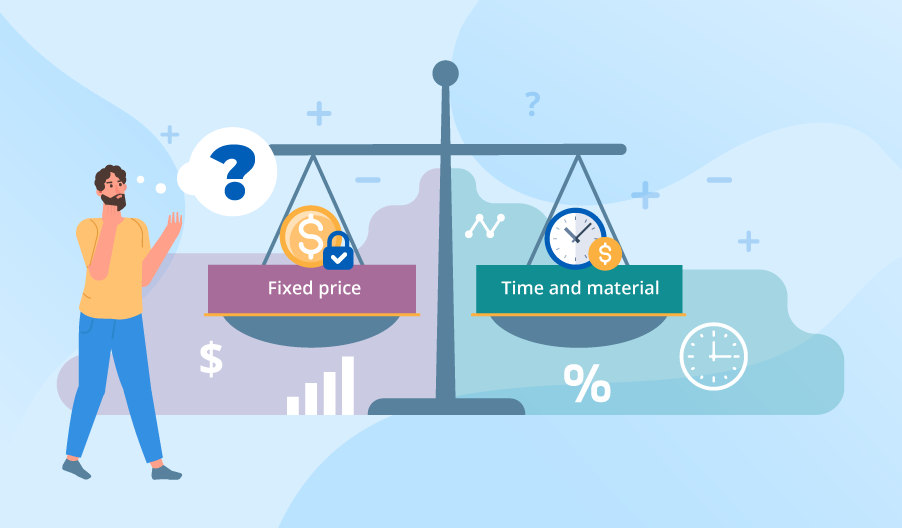Time and Material vs. Fixed Price: What Works for Your Project?
Editor’s note: To help you decide which payment model is safer for your outsourcing initiative, Nick overviews two popular outsourcing payment models in this article. When you’re ready to look for a vendor to take up your project, feel free to check our outsourced development offer.
In software development outsourcing, the choice between payment models – fixed price and time and material (T&M) – is not only about economic benefits and risks. It largely shapes the nature of your cooperation with a vendor and the project’s flow.
I believe there’s no universal truth on which model is better, as it depends on the context of your project. Below, I structure the information we usually discuss with ScienceSoft’s customers to help them decide on the outsourcing payment model. You are welcome to apply it to your project as well as to make a choice.

Fixed price model
For a fixed price project, a vendor prepares a project quotation that defines a complete scope of work and the delivery cost and timelines upfront. The fixed price contract naturally aligns with the Waterfall project methodology, where each stage follows after the previous one is finished. You pay the cost in installments as the project unfolds, with the payment schedule usually dictated by the project’s milestones and duration.
Fixed price pros
- Budget and timeline transparency. You know from the start how much you’ll need to pay and when the project is to be finished. The predictability of a fixed price contract is helpful if you have a strictly limited budget and/or rigid timelines (say, in governmental projects).
- Clarity on the project outcomes. You have an elaborate understanding of what your software will be capable of right at the beginning of the project, so you have time to make it a thought-out part of your business strategy (for example, estimate its influence on business processes, prepare a plan on adopting software and integrating it into your employees’ workflows).
- Little management efforts. Your contribution is the most intense at the planning stage. After the project begins, you get your resources freed up and can narrow your involvement down to scope compliance checks, which is convenient to do with the precise specification and timeline at hand.
Fixed price cons
- Slow project launch. As the pre-condition for a fixed price project is to have very detailed software specifications, the time to create it can take several weeks or even a month, depending on software complexity.
- Hard to near impossible to make alterations. Any changes you may want to introduce further in the project (for example, driven by shifts in market conditions or your business strategy) would require separate negotiation and payment and can stall development.
- Inability to try the software before it’s delivered. Although you control the progress of the software development team, you can’t see the software in practice before the last development stage and ensure it fully aligns with your expectations. Correcting any inconsistencies at the final stage would be a costly process: a lengthy adjustment of a testing process can come up as a whole new project in some cases.
Fixed price use cases
I recommend the fixed price contract for small and midsize fully outsourced projects that don’t exceed 1–3 months of duration. At ScienceSoft, we also apply this model for PoCs and MVPs, as it allows businesses to field-test software concepts or check a new vendor’s experience in action with minimized budget risks.
Time and material (T&M) model
With a time and material contract, you’re charged for the actual time spent on development based on an hourly rate for each outsourced specialist involved. Major factors affecting the development budget are described in detail in ScienceSoft CTO's article on software development costs.
The projects based on the time and material model are Agile-oriented. As a rule, a vendor issues monthly invoices accompanied by reports to give you an integrated insight into the work completed.
T&M pros
- Adaptability. Together with a vendor, you agree on a project roadmap and set related milestones, but the scope of work remains dynamic and can be changed as you see fit. You can make informed decisions on the next steps of development, drawing on the outcomes of the previous ones (end-user feedback) and the analysis of the latest market tendencies.
- Fast project launch. The planning stage is shorter compared to a fixed price project as software specifications don’t need to be as detailed, meaning you can start the active work on software development earlier.
- Continuous quality assurance. T&M-based development goes in hand with continuous testing to verify the implementation of requested changes and new features, so the software gets honed to perfection throughout multiple project iterations.
T&M cons
- Uncertain budget and deadlines. The final cost can go beyond the expected budget. The same applies to the release dates. One way to add some clarity is to measure a team’s progress with KPIs that help predict and plan the scope of work more precisely over time (such KPIs are team velocity, lead time, and cycle time). For more information, you can refer to our CTO’s article on the project health KPIs.
- Increased management efforts. Although the T&M model allows controlling the deliverables, you still need to allocate enough resources to collaborate with a vendor and provide prompt feedback to keep a steady development pace.
T&M use cases
I suggest using this model for midsize and large fully outsourced projects with flexible requirements. The customer’s involvement can vary, though, from regular approval of the next iteration plan to intense collaboration on determining this plan.
The time and material model also works well for other outsourcing collaboration models – IT staff augmentation and dedicated teams. The reason is that you can get the exact number of outsourced specialists and adjust their workload (and your expenses consequently) on a daily/weekly basis. Explore our dedicated article on outsourcing models to learn more about these types of vendor engagement.
Summing up the major considerations
| Fixed price model | Time and material (T&M) model | |
|---|---|---|
| Development methodology | Waterfall | Agile |
| Scope | Clarified and fixed from the onset | Dynamic. The detailed scope is defined at the beginning of each development iteration |
| Budget | Predefined | Uncertain, rests on top-down estimates |
| Timelines | Highly predictable | Uncertain due to scope alterations |
| Project onboarding | Slow due to a comprehensive planning process | Quick due to no need for detailed specifications |
| Quality controls | No possibility to check software quality until the project is completed | Full visibility into software quality throughout the SDLC. The ability to receive early user feedback |
| Involvement | High at the planning stage, minimized at later SDLC stages | Deep and continuous to provide prompt feedback and drive the progress |
| Change implications | Scope changes midway may stall the progress and involve costly plan adjustments | Changes can be accommodated flexibly |
| Best for |
Small and midsize projects with defined scope Isolated development tasks (PoC or MVP delivery, building a particular feature) |
Midsize and large projects with changing scope Long-term initiatives (e.g., digital transformation, R&D projects) |
Weighing your payment options
So, to choose the adequate payment model, you need to evaluate the following factors:
- The time and budget you can dispose of (strictly fixed or relatively flexible).
- Your software vision (clear or vague).
- Project scale (small, midsize, or large).
- The level of involvement you want and can afford (periodic check-ups or deep collaboration).
- The impact that external factors like market volatility or regulatory changes may have on your project.
If you want to verify your decision with an outsourced development provider and discuss related outsourcing opportunities, you can always get in touch with ScienceSoft’s team.

